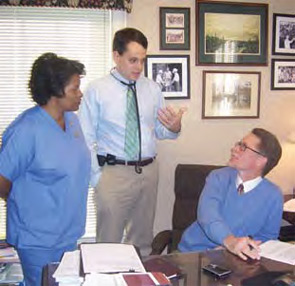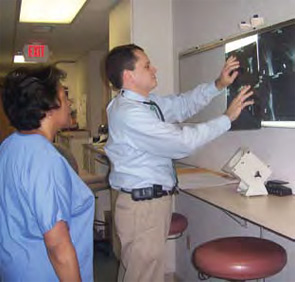Editor’s Note: This is the first in a two-part series about rheumatology health professionals who can help ease the time crunch for busy practices. Click here to read Part Two, about nurse practitioners.
Victor McMillan, MD, began his practice of rheumatology in 1991 as the sole rheumatologist in the multispecialty McIntosh Clinic in Thomasville, Ga. “As I was building the practice,” he recalls, “I very quickly began to see that I was going to need another practitioner to keep up with the patient demand.” He started “borrowing” the time of his partners’ nurse practitioners (NPs) and soon realized the usefulness of this strategy. What he really needed, though, was a dedicated practitioner to help expand his practice. He started recruiting for a physician assistant (PA), and eventually hired Benjamin J. Smith, PA-C. “It’s been a long marriage,” Dr. McMillan says of his and Smith’s association since 1999, the year he hired Smith.
An aging population is increasing demand for rheumatologists at a time when they are in short supply, so Dr. McMillan did what many of his rheumatology colleagues have done to deal with the workforce shortages in their field. A 2003 survey by the ACR found that one-fifth of the ACR membership employed an NP or PA in their practices. The trend is likely to increase: In 2007, the ACR’s Workforce Study Advisory Group projected that demand for rheumatologists in 2025 will exceed supply by 2,575 adult and 33 pediatric rheumatologists.1 The Advisory Group recommended, and the ACR endorsed, a strategy of expanding the use of rheumatology NPs and PAs as one way to address the workforce shortages.2
Rheumatology PAs provide a wide range of services, from evaluating new patients and managing ongoing patients to prescribing medication and performing procedures such as joint aspirations. Joan McTigue, MS, PA-C, a faculty member in the division of rheumatology at the University of Florida College of Medicine and the Veterans Affairs (VA) Medical Center in Gainesville, Fla., believes that most rheumatologists have a better sense of the role of PAs and the ways in which they can help to “decompress” a practice. That’s because they likely encountered them during their training. Still, some rheumatologists may not be familiar with PAs’ scope of practice and how they can be appropriately incorporated into a busy rheumatology practice.
The Rheumatology PA Profile
PAs have been a presence in U.S. healthcare delivery for 45 years and active in rheumatology for over 40 years. Estimates of their numbers in rheumatology vary. A report prepared for the Society of Physician Assistants in Rheumatology (SPAR) in 2008 identified 86 PAs specializing in rheumatology out of a total of more than 75,000 PAs who were eligible to practice nationwide.3 Another survey identified 112 rheumatology PAs by plumbing the SPAR, ARHP, and American Academy of Physician Assistants (AAPA) databases.4
The latter survey found that 71% of rheumatology PAs were female and that they worked in a variety of practice settings: 29% in solo practices, 16% in dual-doctor partnerships, 29% in group practices, 10% in government (the VA, military, or public sector), and 16% in academic practice settings.
In the time that he has been working in rheumatology, Smith, who is also president-elect of the ARHP, has seen “a definite increase in the awareness of physician assistants and their use in medical practice.”
The Working Relationship
PAs practice under state licensing rules, which stipulate that they are under the supervision of the physician. “State licensing is more homogenous now than it has ever been,” notes labor analyst Roderick Hooker, PhD, PA, senior director at The Lewin Group in Falls Church, Va., where he is an analyst and economist. His work centers on predictive modeling of health professions’ workforce for the federal government and associations such as the ACR.
If [by using PAs and NPs] you have the same results in those four elements of care, but the labor cost is more economical, why not use that labor?
— Roderick Hooker, PhD, PA
Dr. Hooker notes that the ways in which rheumatologists and PAs work out their spheres of care vary from practice to practice and tend to maximize access and care for the patient. At the McIntosh Clinic, Smith initially sees new patients to gather a history and perform a general physical examination and then he presents the patient to Dr. McMillan, who proceeds to obtain the history of present illness and a musculoskeletal and problem-focused exam, and then formulates the assessment and plan of management. Smith now handles a large part of the routine follow-up visits, says Dr. McMillan. “Our working relationship has continued in much the same way that I originally set it up. You have to find the right person, and someone who is not a risk taker who is going to go off on their own to do something beyond their level [of expertise].”
McTigue and her supervising physician, N. Lawrence Edwards, MD, professor of medicine in rheumatology and clinical immunology at the University of Florida, have worked out their interactions with patients to address the complexity of pain medication management. For example, it can be necessary to reiterate and enforce certain rules such as no early refills of pain medications without office visits. “Sometimes,” she says, “we have this drill called ‘good cop/bad cop’ where we switch roles depending on who best interacts with the patient.” In this way, they’re able to clarify to patients that pain management with medication is a mutual responsibility.
Dr. Hooker worked in a variety of settings throughout his 32-year career as a dual researcher/clinician. While with Kaiser Permanente’s Northwest Division in Portland, Ore., he practiced with two staff rheumatologists. The three decided that all of Hooker’s charts would be reviewed by one of the rheumatologists. “The Kaiser policy did not require this. Our rationale for that was good supervision. PAs were still a novelty at that time [1978], so we were just being prudent,” he says. What they found after two years is that all three developed familiarity with each other’s patients, so covering for their colleagues was easier. They also found that their areas of interest dovetailed. Dr. Hooker was procedures oriented, so he performed the majority of joint injections and muscle biopsies; one of the rheumatologists had a special interest in fibromyalgia, so he saw the majority of those patients.
Dr. Hooker’s colleagues always saw his notes, and he sometimes would ask for a hallway consult if an intriguing or puzzling case came up. “We felt like we were catching omissions better as a team,” he says. “We thought that three heads were better than one!”

Commitment Required
Hiring a PA is both a monetary and a time commitment. PAs’ salaries depend on geographic region and range from $60,000 to $112,000.3 Health benefits, professional liability insurance, pension funding, professional society dues, and continuing medical education funding are also included in the compensation for full-time PAs.3
Whether hiring an experienced rheumatology PA or someone who has worked in another specialty, there will be a learning curve as the new hire learns your practice’s procedures. Smith came “highly recommended” but had not yet practiced as a PA when Dr. McMillan hired him. Hiring a PA fresh out of school can have its advantages and disadvantages, says Dr. McMillan. The advantage was that he could train Smith in the fashion he wanted. But, just as with anyone you’re teaching, the process can be time consuming. “I started bringing [Smith] along with the basics, had him do basic reading, saw patients with him, and discussed those patients,” Dr. McMillan says. “He’s been with me since 1999 now, so he knows a lot of rheumatology.”
Setting the Tone
When physicians hire PAs, they should take certain steps to be sure that they will be well integrated into the practice, says McTigue. The practice should have a policy ensuring that patients have the right to consent (or not) to seeing a PA, and frontline staff should buy into and endorse the PA’s role.
Smith has found the reception to be very good at McIntosh Clinic. “Patients recognize that Dr. McMillan and I are a team and value the opinion and input that we are able to offer,” he says. Some of that reception has undoubtedly been due to the fact that waiting time was reduced once he came on board at the clinic.
SPAR Vice President Antonio (Tony) Giannelli, MsA, PA-C, who has been practicing rheumatology for the past 16 years, works three days at Associated Internal Medicine Specialists, a multispecialty practice with three rheumatologists in Battle Creek, Mich., and another two days a week for a solo practice, Lansing Rheumatology in East Lansing. He reports that “most of the time, patients feel very comfortable after the first encounter with the PA.” It can work well, he says, to have the PA gather baseline information from new patients, “as long as everybody feels comfortable and the communication is smooth between the rheumatologist and the PA. I think that’s the key to everything.”

Training Initiatives and Resources
Traditionally, most rheumatology PAs have acquired their training on the job. The opportunities are expanding for rheumatology PAs, but the training has come slowly, according to Dr. Hooker. The ACR and ARHP recently co-developed an online 19-module educational program on all aspects of rheumatologic care, from basic immunology to the musculoskeletal exam, to imaging, in specific adult and pediatric disease states. That course, the Advanced Rheumatology Course, can be accessed at www.rheumatology.org/education.
At the University of Texas Southwestern Medical Center in Dallas, Dr. Hooker and rheumatologist Salahuddin Kazi, MD, initiated a rheumatology fellowship for PAs in 2003, under a VA demonstration project that lasted four years.
In addition, SPAR leaders and other long-time rheumatology PAs are eager to attract more PAs in training to their specialty. For the last three years, Giannelli has done a rheumatology lecture series to PAs in training at Western Michigan University, where David Areaux, MPAS, PA-C, is assistant professor. In two 4-hour classes, he covers the basics of rheumatology to impart the enthusiasm that he has for his chosen field. Other colleagues (including Rick Pope, PA-C, from Connecticut and Linda Davis, PA-C, MHS, from Georgia) are embarking on the same mission in their regions, he reports. He has initiated collaborations with other PA training programs in Michigan to foster more interest in rheumatology, better prepare students for an aging population, and perhaps choose it as a postgraduate selection. “We call his lectures ‘Rheumatology 101,’” says Areaux. “Already a few students have indicated they want to do more rheumatology when they select an elective for their second year rotations, so he has definitely piqued their interest.” For more on PA training programs, visit www.rheumpas.org to watch a video on “Successful Collaboration on Education,” created by SPAR.
These and other outreach efforts will be needed in the future. Just as rheumatologists are experiencing increased demand, the demand for the practiced rheumatology PA is also increasing.
References
- Deal CL, Hooker R, Harrington T, et al. The United States rheumatology workforce: Supply and demand, 2005-2025. Arthritis Rheum. 2007;56:722-729.
- Birnbaum, N. American College of Rheumatology response to the 2006 Rheumatology Workforce Study. Arthritis Rheum. 2007;56:730-731.
- Hooker RS. Characteristics of physician assistants in rheumatology practices: 2008. Available at www.rheumpas.org/documents/2008_Report_on_Rheum_PAs_Census.pdf. Accessed May 10, 2011.
- Hooker RS, Rangan BV. Role delineation of rheumatology physician assistants. J Clin Rheumatol. 2008;14:202-205.
Partner or PA?

Do you need a partner or a PA to decompress your practice and improve access to care? That decision, says SPAR Vice President Antonio (Tony) Giannelli, MsA, PA-C, depends somewhat on practice dynamics, such as the age of the rheumatologists and whether you have a solo practice. Dr. McMillan does not think the choice of partner or PA to increase practice capacity is an either/or proposition. In fact, he is in the process of hiring another rheumatologist as a partner and may also take on another PA. As with other hiring situations, he says, “it’s critical to hire someone who is affable, has good communication skills, and whose thinking fits with the culture of the practice.”
In order to decide between taking on a partner or hiring a PA, McTigue says it can be helpful to assess what area of the practice could benefit from decompression. Are there routine tasks that do not require physician-level expertise? For example, stable patients on disease-modifying antirheumatic drugs or biologic therapies require monitoring that can be done by a PA. Patients with chronic rheumatic diseases often have trouble adjusting psychologically to their chronic conditions, and PAs are ideally suited to evaluate whether patients could benefit from referrals to other health professionals, such as physical therapists or occupational therapists.
McTigue advises rheumatologists who are exploring the possibility of hiring a PA to consult other colleagues who have done so. In that way, they can get a sense of the time commitment that is involved. “It’s a learning curve for someone who has not had exposure to what PAs can do,” she says. This may also help physicians filter out whether they simply need someone to answer more phone calls (such as a nurse), or whether what they really need is a partner to help with the patient load.
As a long-time workforce economics researcher, Dr. Hooker applies economic principles to the decision. Work by Dr. Hooker and others has shown that using PAs and NPs does not compromise the four principle elements of cost effectiveness in healthcare delivery—outcomes, patient satisfaction, patient safety, and effectiveness of treatment. He reasons that the same economic principles used to choose efficacious treatments can also be applied to the use of PA and NP providers. For example, if two medications for RA produce the same benefit, but one is more expensive, why not use the less expensive one? Commensurately, “If [by using PAs and NPs] you have the same results in those four elements of care, but the labor cost is more economical, why not use that labor?” The role of the rheumatologist, he notes, is to set the standards of care, but there is an opportunity to improve the delivery of care by incorporating a division of labor and economy of scale that enhances care and produces an improved outcome.

